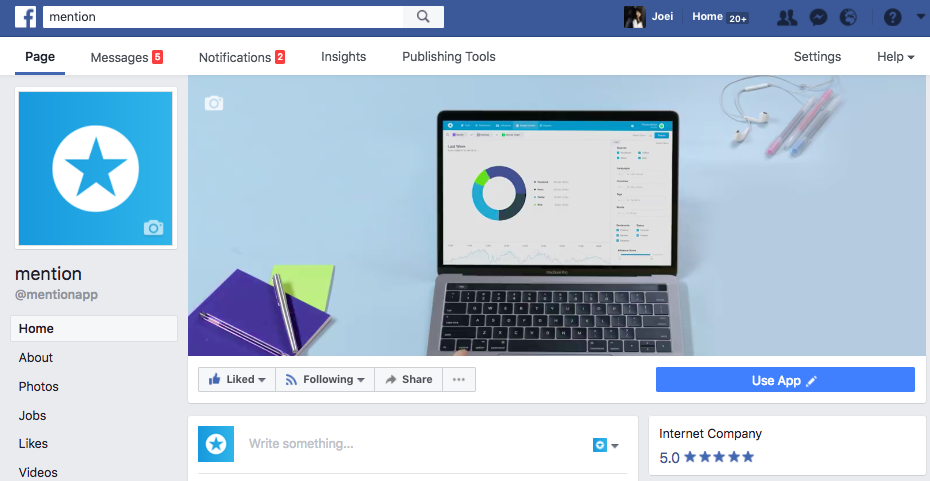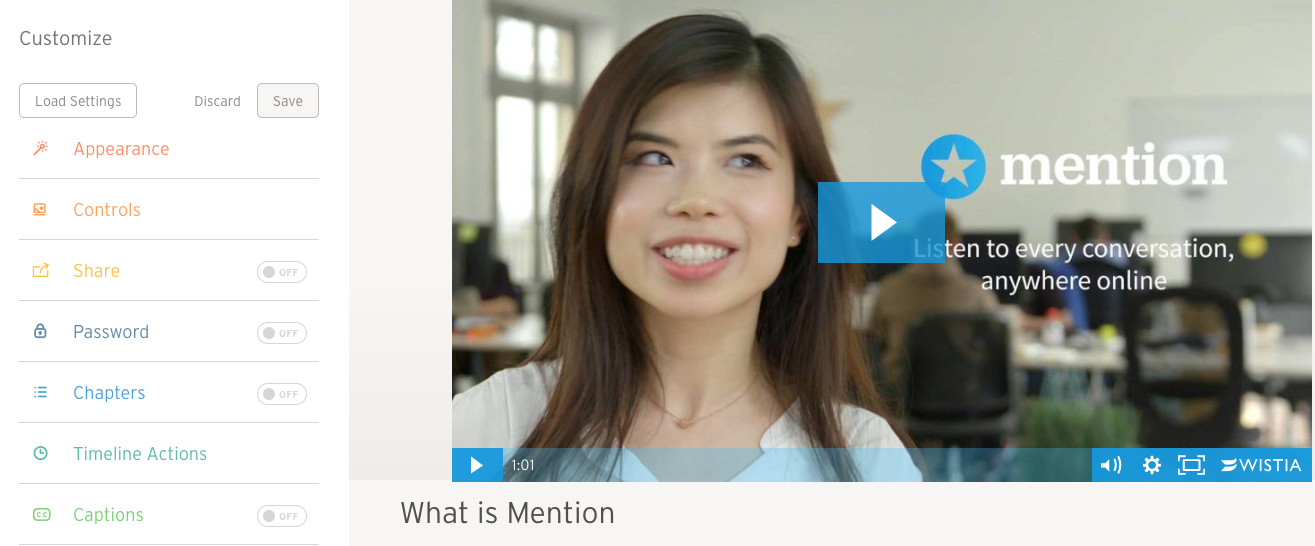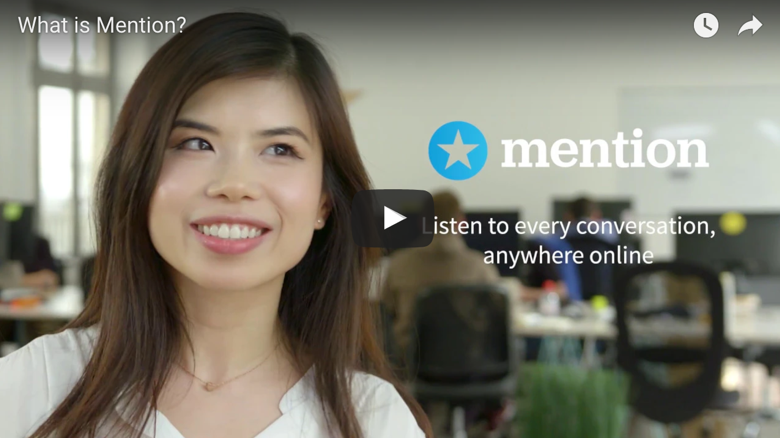So, what’s Mention anyway?
We get that question a lot. The thing is, it’s not always easy to understand what Mention does, what media monitoring is, or how we make your life easier.
So we decided to create a long overdue but short video to explain just that. It wasn’t easy, but we’re very glad we did it, and are quite happy with how it turned out:
So that’s our video. It’s only a minute long. But it took no less than 160 hours of researching, brainstorming, writing, a bit of screaming, and lots of trying. We learned heaps, and we’d like to share all of it with you.
If you’re thinking of creating a product video but don’t know where to start, read on to see every step we took and learn from our experience.
1. Set your goals for your product video
Like any piece of content, you need to know what your goals are before you start. This not only helps you choose the right video format, but also helps you brainstorm ideas.
There are many ways brands can use videos in different stages of the customer journey. A study by Biteable showed that around a third of businesses use video for sales while 20% of businesses use video for product management and customer support messages. Depending on what your business needs are, you may want a video for any of these purposes:
- Building brand awareness: introduce a need for your product and make your brand look good
- Generating leads or sales: convincing prospects to get in touch or buy
- Explaining specific features: educating existing customers to improve adoption and retention
Your goals help you determine the kind of video you should produce. If you’re looking to build brand awareness – do a short ad. Want to improve customer retention? Create video tutorials for different features.
Once you have your goals set, it’ll be much easier to proceed with the next steps like writing the script, choosing the tone, etc.
For us, we wanted to have a short, catchy video that tells people what we do. We’ve had customers and prospects tell us that they love how we’ve got tons of resources and content about media monitoring and marketing, but find it weird that we don’t have one short intro to what Mention is.
Our sales team also receive a ton of demo requests from people who have no clue what Mention does. We suspect that this might be because we didn’t have a lot of information on our demo request page:

So we thought having a one-minute explainer video could help clarify what we do to potential customers and make our sales reps’ lives easier.
TLDR: ask yourself, why are we doing this video? What problem are we trying to solve with it?
2. Identify your target audience and value proposition
Setting your goals is the first step. Then you need to know who you’re addressing and the message you need to convey.
First, who is this video for? If your answer is “well, everyone?” you might need to spend a bit of time doing some serious research.
Knowing who your ideal customers are will help you choose the best tone and language to address them, increasing your video’s effectiveness.
Then you need to ask, what do we want to emphasize in the video? What is your biggest selling point? Why should people care?
These questions should help you narrow your focus on just the essence and highlights of your product in the video, and make them memorable for your viewers.
Here are some ways to identify your target audience and value proposition:
- Ask your sales team. They talk to customers all day long. They know the kind of people who’re most likely to buy, what they care and worry about, and how they speak.
- Talk to your customers. The best way to understand your customers is to talk to them. Ask them why they chose your product over a competitor’s, what they like most about your product, how they use it, etc.
- Monitor your brand discussions. Sometimes your customers might not want to speak to you. They might just want to share their opinions with their followers and friends. Or they may just want to leave a review online. Keeping a close eye on all your brand related conversations will help you understand them better – what they really think about your brand, as well as the language they use when communicating.
- Steal ideas from your competitors. Your competitors’ customers are your best prospects. Spy on your competitors to see what kind of people they are targeting, and how they’re targeting them.
When we started our video project, we asked the sales team to describe our ideal client types, and the Mention features that speak to them the most. From monitoring online reviews, we found that ease of use is what our customers appreciate the most about our tool, compared to our competitors.
With that information in mind, we proceeded to writing our script and creating the storyboard.
TLDR: do your homework to find out who your target audience are and what they care about the most to determine your video content and tone.
3. Draft a script and storyboard based on your target audience
Once you decided on your target audience, tone, and value proposition, you can start drafting your script and storyboard.
In the past, we’ve always done our videos in house. Like our Real Smart Marketing series, and all our customer success story videos. But because of the time constraint and how busy our design team is with other projects, we’ve decided to go for a video production agency – Left Productions – for our product explainer video.
But we still felt it was important for us to write our own script. So we did.
Writing your script
The script is the foundation of your entire video. Like the script of a movie, basically. If you’ve attended any screenwriting class in college, you’ll know that a good story needs some sort of conflict, and then a resolution. Same goes for a good product video.
Setting up the challenge
You need to first set up the context and the challenges faced by your target audience. Then, you introduce your product as a solution to their challenge.
For our customers, their biggest challenge is keeping track of all brand discussions happening on different channels online. We thought it’s better to illustrate this challenge visually. So we decided to go for animations to create this overwhelming feeling of being drowned in different social media discussions in the beginning.
Use the right tone to reflect your brand
The tone of your video should represent your brand voice and what you’re selling. If you’re representing yourself as a smart solution, sound smart. If you’re a dating app, sound fun and flirty.
Since we want to highlight the fact that we’re easy to use, we chose a very conversational, straight-to-the-point tone, free of jargons and corporate terms.
You also need to speak your audience’s language. Are they tech geeks who like to use technical terms? Or are they teenagers who speak in emojis? To connect with and convince your audience, you have to use the same language as them.
Talk benefits, not features
Your customers don’t care about you. Or your product. They care about themselves, and their problems. The only way to get them to care about your product is to show them how you can solve their problems.
So if you’re selling a drill, talk about the hole that your prospect needs on her wall. The drill is the feature, the hole is the benefit. Your script needs to be all about the benefits. It’s okay to touch on features, but only when you show how it can help your customers.
Choose words that reinforce your central idea
In your video, you should have one theme or central idea.
For us, we want to drive home the idea that Mention helps brands listen and understand better. So I chose words and phrases that are synonyms of “listen” and “understand.” I also bolded those phrases so that they stand out to me as I was drafting and reading the script to myself.

Have a compelling call-to-action (CTA)
At the end of your video, your viewers should be prompted to take an action. This goes back to your goal. What is this video for?
Some common CTAs are:
- Contact us
- Download our thing
- Buy our stuff
- Subscribe to our mailing list
- Visit our website
When you’ve decided what your CTA is, make sure to include it at the end of your script.
Drafting your storyboard
Once you’ve perfected your script, you’re ready to create the video’s storyboard. A storyboard lays out exactly what you want to show in the video, frame per frame.
So from the script, ask yourself, what am I showing on the screen as I’m saying this?
My original storyboard looked like this:

…Yeah, I should stick to writing, I know.
Together with our video agency, we worked on a storyboard that’s a tad more polish and comprehensible:

Since we really focused on the benefits our tool bring to our customers in the script, we felt it’s okay for us to show our product and features visually.
From the discussion with our sales team, we identified a few key features that we want to highlight and made sure to feature them in the video.
Be neurotic about it
When it comes to storyboarding, you need to be super detail-oriented.
From the second the music should come in, to the wording you’re using on the screenshot of your app, you need to have every single detail carefully thought and planned out.
If you’re working with an agency, don’t be afraid to ask lots of questions about every single scene and transition. Having a clear and detailed storyboard will save both sides a lot of time later in post-production.
Get an outsider’s point of view
After spending two weeks looking at our storyboard, we couldn’t tell what rocked and what sucked anymore.
So we invited the sales, tech, and design team to comment on our ideas. They were able to look at it with fresh eyes and gave us very useful insights to improve our video.
Since we have an international audience, having the opinion of non-native English speakers also helped us fine-tune the wording and slangs we used.
4. Filming, actors, and voiceover
For us, the filming was really the easiest part of the whole video production.
Since we worked with an agency, they came bringing all the equipment, and it took us less than an hour to get all the shots we needed.

And because we believe it’s important to show our customers the people behind the Mention brand, we’ve decided to feature real employees at Mention in the video instead of hiring actors.
Here’s Julian, a real account manager at Mention 🙂

As for the voiceover, I rehearsed and experimented a few different versions with the crew in a quiet room, and that’s a wrap!
TLDR: If you don’t have an in-house video crew, it’s best to go for a good agency to save time and headaches.
5. Diffusing your video
Once your video is ready, you need to get it out there for the world to see.
Based on your goals, you have to decide where you want to share and host your video.
Here are a few common options:
- A landing page
- Your website homepage
- Social media platforms
- Nurturing emails
Since our goal is increasing brand awareness and product value proposition, we’ve put our video on our demo request page:

And pinned it as the top post/featured content on our social media accounts:



We also named the YouTube video “what is Mention?” so when people search for that on Google and choose “videos,” they’ll find our product video easily.
Hosting your video
Normally we host all our videos on YouTube. It’s everybody’s go-to platform for videos, and if we target the right keywords we can reach a big audience that’s never heard of us. It being completely free also helps.
The only problem is, when we embed a YouTube video, people can click away from our page to watch on YouTube instead, thus less likely to continue reading or doing what we want them to. YouTube also display lots of ads and suggested videos, which may very well be one of our competitors’.
So that’s when we decided to give Wistia a try, which has no ads, and no way for viewers to click away from the page.
When you embed videos on your site, you’ll enjoy full control over the branding, including the option to add social sharing buttons, a clickable call to action, divide the video into different chapters, etc.

We’re currently just trying out the free plan, but we may upgrade to get integrations with HubSpot, our marketing automation tool, to get more viewing analytics to improve our video strategy.
Start creating your product video
Creating a product video was much more challenging than I thought. It’s a lot of work, and the enthusiasm turns into anguish as you’re working on V5 of your script. But there’s also nothing more rewarding than seeing a finished product that you’re happy with, and are proud to show the world.
What do you think about our video? Does it make you want to give our tool a try? Let us know in the comments!







